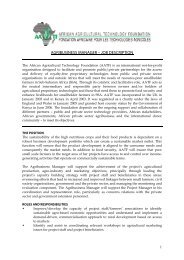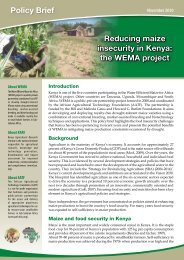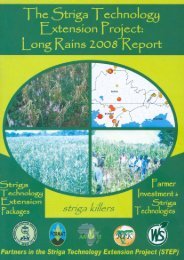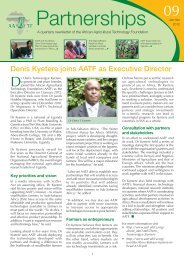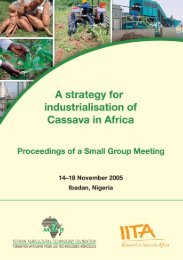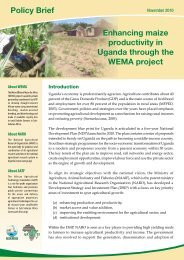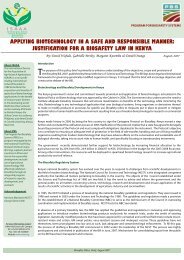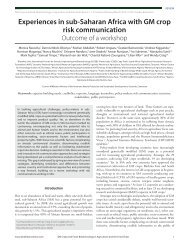Baseline Study of Striga Control using IR Maize in Western Kenya
Baseline Study of Striga Control using IR Maize in Western Kenya
Baseline Study of Striga Control using IR Maize in Western Kenya
You also want an ePaper? Increase the reach of your titles
YUMPU automatically turns print PDFs into web optimized ePapers that Google loves.
Table 4.7. Current use status <strong>of</strong> modern <strong>Striga</strong> control technologiesNyanza<strong>Western</strong>N 402 4001 * 2 * 3 * 1 * 2 * 3 *<strong>IR</strong> maize variety, Ua Kayongo (%) 0.2 0 1.2 0.3 0 1.5<strong>Striga</strong> resistant maize with legumes (%) 1 0.2 2 2.0 0 1.5<strong>Striga</strong> resistant maize without legumes (%) 0.2 0 1.7 1.3 0.8 0.3Intercropp<strong>in</strong>g <strong>of</strong> legumes followed by2.5 0.2 2.5 1.0 0 1.5cassava/Desmodium (%)Push-pull, maize–Desmodium strip cropp<strong>in</strong>g (%) 0 0 2.7 0.3 0.3 5.81* = Currently <strong>us<strong>in</strong>g</strong>, 2* = Abandoned, 3* = Never adoptedN = Number <strong>of</strong> respondents4.6 Sources <strong>of</strong> <strong>in</strong>formation on modern <strong>Striga</strong> control technologiesIn Nyanza prov<strong>in</strong>ce several media have been useful <strong>in</strong> promot<strong>in</strong>g the awareness <strong>of</strong> modern<strong>Striga</strong> control technologies available to farmers, although the level <strong>of</strong> success is not veryhigh. The results <strong>in</strong> Table 4.8 show patterns for <strong>Western</strong> prov<strong>in</strong>ce that are similar to those <strong>of</strong>Nyanza prov<strong>in</strong>ce.Little has been done to promote the <strong>IR</strong> maize technology. Table 4.8 below shows the source<strong>of</strong> <strong>in</strong>formation on <strong>IR</strong> maize among the farmers <strong>in</strong> the two prov<strong>in</strong>ces.Table 4.8. Sources <strong>of</strong> <strong>in</strong>formation on <strong>IR</strong> maize (% <strong>of</strong> respondents)Nyanza<strong>Western</strong>N 402 400Farmers <strong>in</strong> the village 0.2 0.3Farmers <strong>in</strong> other villages 0 0.3Mass media 0.7 0.8Extension agents 0.5 0.0Local NGOs 0 0.5International Research Institutes 0 0.0National Research Institutes 0 0.0Others 0 0N = Number <strong>of</strong> respondents4.7 Sources <strong>of</strong> seed and knowledge <strong>of</strong> management practice for modern <strong>Striga</strong> controltechnologiesApart from hav<strong>in</strong>g access to <strong>in</strong>formation about a new technology, one other crucial stage <strong>in</strong>the technology adoption pathway is the possibility <strong>of</strong> test<strong>in</strong>g (validat<strong>in</strong>g) the technology andits potential. Potential adopters would require the hardware component (for example seed)and the s<strong>of</strong>tware component (for example management practices) <strong>in</strong> order to be able to passthrough the validation stage successfully.The respondents <strong>in</strong>dicated poor access to seed <strong>in</strong> spite <strong>of</strong> the fact that some <strong>of</strong> the modern<strong>Striga</strong> control technologies have been available <strong>in</strong> the region for some time. The scenari<strong>of</strong>lows logically from a situation <strong>of</strong> low level <strong>of</strong> awareness through low level <strong>of</strong> <strong>in</strong>formationdissem<strong>in</strong>ation to the stage <strong>of</strong> poor access to the required seed and knowledge about cropmanagement practices.Concern<strong>in</strong>g <strong>IR</strong> maize, farmer-to-farmer diffusion channel represented 0.2% <strong>of</strong> the sources <strong>of</strong>seed. The percentages were 0.5% for extension agents and 0.7% for national research<strong>in</strong>stitutes (KARI) <strong>in</strong> Nyanza. For <strong>Western</strong> prov<strong>in</strong>ce, KARI and CIMMYT were major sources30





